'The train is on fire': tense moments after an oil train derailed
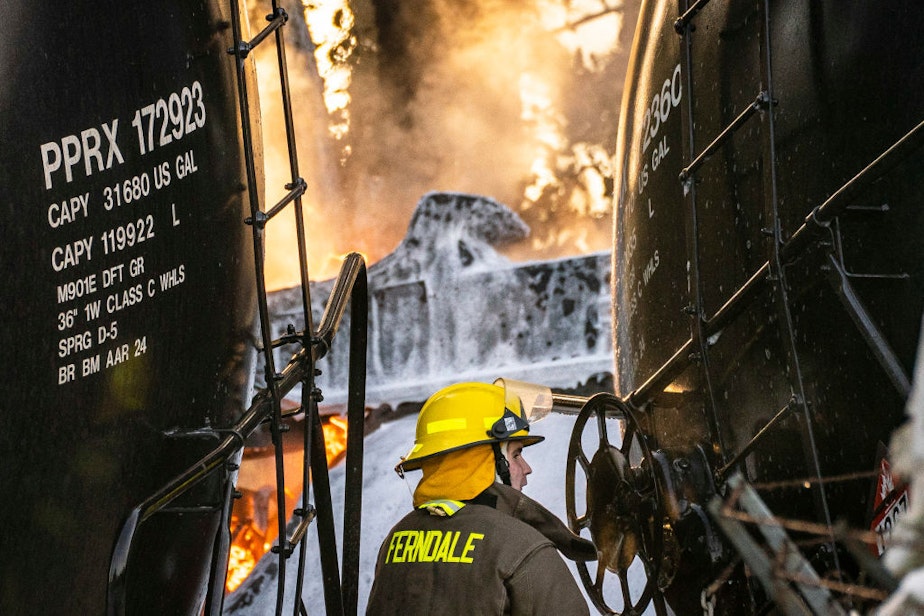
The day started like many others in Washington state, with a long line of tanker cars carrying crude oil to a refinery on the shores of Puget Sound.
Western Washington’s five oil refineries make the gasoline, diesel and jet fuel that keep the Northwest moving.
As the sun came up Dec. 22, a mile-long train full of oil was heading to the Phillips 66 refinery north of Bellingham after a winding journey from the drilling fields of North Dakota. It had passed Spokane and the Tri-Cities, then rumbled down the Columbia River Gorge, beneath downtown Seattle and up the coastline of Puget Sound.
But before the morning was over, toxic smoke would darken the skies above the tiny trackside town of Custer as that train derailed and caught fire.
What caused the oil train to burst into flames 80 miles north of Seattle probably won’t be known until the FBI and other agencies complete their investigations months from now.
But KUOW has been able to piece together a portrait of much of what happened that morning.
This account is based on interviews and statements of union, government and BNSF Railway officials, as well as photos, videos, public records and scanner traffic from the disaster site.
This is part 1 of a two-part story on the train derailment. Read part 2 here. Listen to the Seattle Now podcast episode on it here.
Sponsored
Disclosure: BNSF Railway is a financial supporter of KUOW.
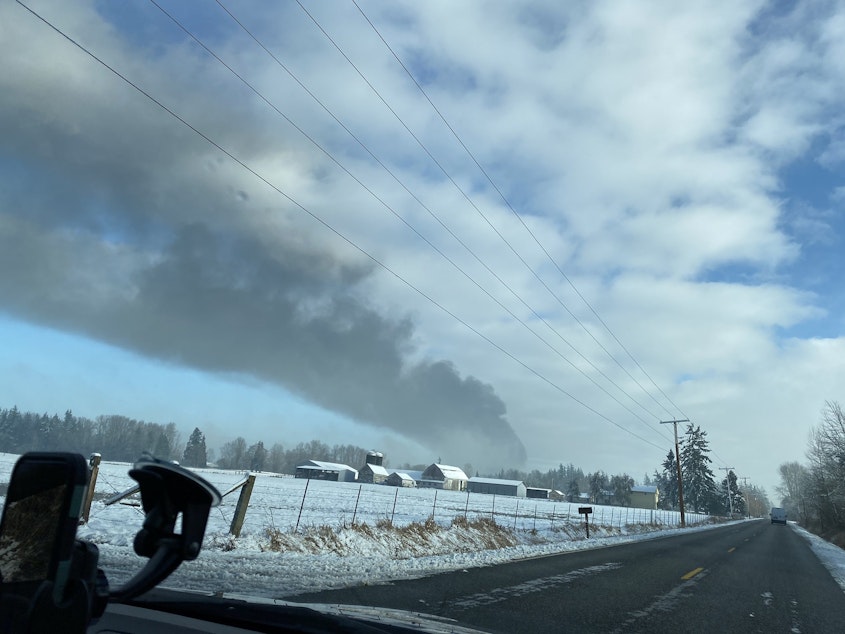
A
round 8:30 a.m., freight traffic ahead forced the train's engineer to stop just south of Custer, a farming town built around these tracks a century ago.
Sponsored
The front end of the train came to a halt amid snowy farms; the back end, next to a business park on the outskirts of the industrial town of Ferndale.
The payload was about 3 million gallons of Bakken crude, an especially flammable fossil fuel involved in fiery railroad disasters in Oregon and elsewhere.
Bakken crude’s volatility has led critics to dub its carriers “bomb trains” and led regulators to tighten safety standards for transporting it after a train explosion killed 47 people in Quebec in 2013.
With 108 cars, this train was some 6,500 feet long. Fully loaded, it was too heavy to take a more direct route over Washington’s mountain passes.
The delay forced the train’s crew to call it a day, according to Herb Krohn with the International Association of Sheet Metal, Air, Rail and Transportation Workers. Krohn’s union represents the BNSF Railway workers.
Sponsored
Federal law prohibits railroad crews from working more than 12 hours straight.
They hand-cranked big metal wheels on the ends of some of the railcars to set their brakes and locked the doors to the locomotives at front and back of the long string of cars. They headed home in a shuttle van around 9:30 a.m., leaving the train unoccupied.
Around 11:15 a.m., nearly two hours later, a van brought a new crew – engineer, conductor and brakeman – to the train.
The engineer and conductor climbed aboard. They started to release brakes and get the train ready to resume chugging northwest along the BNSF tracks that roughly parallel Interstate 5 from Oregon to the Canadian border.
Meanwhile, Krohn said, the brakeman got a lift in the van to the Phillips 66 refinery to make sure the gates were open and ready to receive the shipment of crude by rail. That standard procedure keeps the train from needing to squeal to a stop on the final downhill approach to the seaside refinery, about nine miles by train from Custer.
Sponsored
The engineer guided the front of the train across Main Street in Custer and into an arcing left turn off the main rail line.
From there, a spur heads west to the BP refinery at Cherry Point, then south to the Phillips 66 refinery.
The front half of the train, some 50 tanker cars, rolled slowly across Main Street. The first cars were already heading through the big curve to the west, when something went wrong on the straightaway a half mile behind them.
Two jolts, a second or two apart, nearly threw the crew at the front of the train from their seats.
Ten tanker cars in the middle of the mile-long string ran off the rails, according to Ecology spokesperson David Byers.
Sponsored
Derailing is the nation’s most common type of train wreck.
“Often derailments happen at switches,” Krohn said, but not this one. “There was nothing there. It was completely straight track.”
The speed limit for an oil train on that stretch of track is 10 miles an hour.
According to union and state officials, the train was moving just 7 miles an hour, the pace of a jogger, when its midsection derailed.
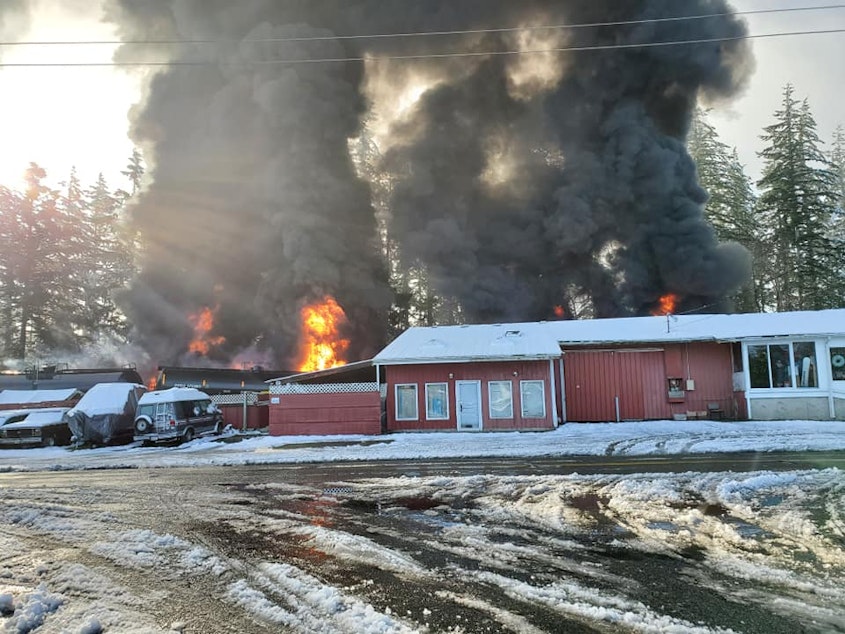
A smoky jumble
Shawn Graham of Ferndale unfurled expletives and worried about his safety as he drove by the flaming railcars and recorded the scene on Facebook Live.
“I better get the f--- out of here,” Graham said. “Holy crap, right here in Custer.”
Thick black plumes billowed above the town.
Seven cars had crashed into a jumbled mess, most on their sides, with at least three catching fire. Three others derailed but stayed upright.
In the van, the brakeman heard the conductor on his hand-held radio – “Emergency, emergency, emergency” – and rushed back to his train.
State officials initially said five tanker cars caught fire. A union official said six. The next day, a BNSF official said three had punctured and caught fire.
“It’s a jumble of rail cars and very smoky,” Byers said. “In the initial hours, it’s very hard to identify.”
The first 911 call came in at 11:39 a.m. Whatcom County deputies and firefighters scrambled to respond, at first not knowing how hazardous a situation they would be facing.
“We’ve got a train derailment. 7500 block Portal Way. The train is on fire,” a county dispatcher told six local law-enforcement agencies over police radio.
“Copy. Do we know if a regular Burlington Northern train or Amtrak?” an officer radioed back.
“My last caller advised it was a tanker,” the dispatcher said. “Unknown what it’s loaded with.”
The first police arrived in 4 minutes and began evacuating people. The first fire engines pulled up 6 minutes later.
It would take about 20 minutes for emergency responders to learn that the tankers were full of crude oil.
Responders had a smartphone app developed by the rail industry called AskRail.
It’s designed to provide emergency responders real-time details – “with the push of a button” – on what hazardous materials a train is carrying, but a fax from BNSF provided the vital intel more quickly.
So did the crew. After picking up the conductor at the front of the train, the crew van headed to the fire scene a half-mile to the south. The crew members handed the train’s manifest, a detailed listing of each railcar’s cargo, to a fire chief.
“Units, advising: Tanker carrying petroleum crude oil, unknown safety distance,” the dispatcher radioed at noon.
About 5 minutes later, the dispatcher advised responders that a blast from the fire could reach a radius of up to 800 meters, or about nine football fields, away.
Meanwhile, responders had set up an initial command post a block away in the parking lot at Tony’s Tavern, a bit more than one football field from the flaming tankers.
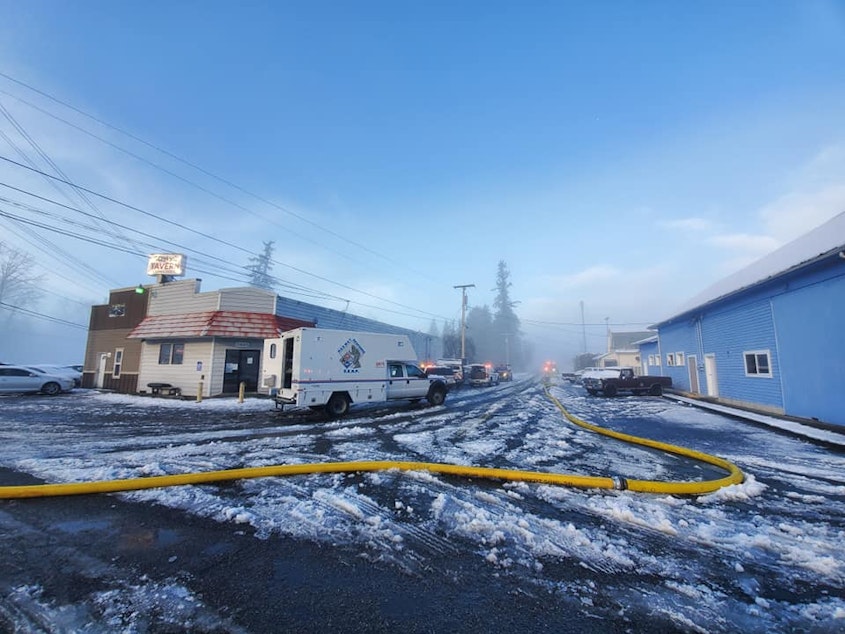
They started closing roads, including Interstate 5, and evacuating a broad swath of the town due to the toxic smoke and risk of a major explosion.
“Make sure county knows to close all arterial roads,” an officer told the dispatcher.
“Whatcom, can you put a call into the school?” a deputy requested.
“The Post Office is right there, too,” another chimed in.
Custer Elementary School was on its second day of winter break, with only two employees in the building. They quickly evacuated.
In the parking lot of the small-town post office, a couple was locked out of the car they had left running.
Inside, their dog had stepped on a lock switch.
A firefighter found them and convinced them to evacuate in his car and call family members to get a key to retrieve their dog and vehicle.
Local police asked for help from neighboring forces and even the U.S. Border Patrol. Firefighters requested help from the specialized fire brigades at the Phillips and BP refineries.
FBI agents arrived and asked responders to minimize disruption to the site since it was a possible crime scene.
“Any Lynden units available, go ahead toward Tony’s Tavern to start evacuating residents,” a dispatcher radioed.
“I’ve got a state patrol unit here going door to door trying to get the rest of these residents next to the train evacuated south,” an officer said.
“Fire is advising, evacuate one-half mile in all directions. One-half mile, all directions,” the dispatcher radioed.
While first responders rushed townspeople to safety, firefighters and the train’s crew had to work quickly to unhook the tankers on fire from the 98 that didn’t derail.
“When you have an oil train fire, if you’ve got a car that’s engulfed, it can be as little as seven minutes before the car next to them could explode due to the heat,” Krohn said.
Firefighters doused the cars nearest the flames with water to keep them from overheating.
To free the unscathed tankers, the train’s engineer would have to drive the locomotive backwards far enough to push the cars together and release any tension on the couplings between them. The conductor or brakeman could then walk between the cars, disengage the emergency air brakes and grab a lever to release a pin holding the cars together. Then the engineer could haul the uncoupled railcars out of harm’s way.
“You do it every day in the railroad, but doing it under these conditions is very, very dangerous,” Krohn said.
The crew managed to remove tanker cars to the north of the flames within half an hour and roll them out of the blast zone. They then drove back to the rear end of the train, despite closed roads and snarled traffic, and pulled cars to the south away within 45 minutes.
“Those crew members were heroes,” Krohn said.
The union and BNSF declined to make the workers available for interviews.
As required by federal law for rail accidents involving hazardous materials, the crew took sobriety and drug tests after the incident. The Federal Railroad Administration declined to release the results during an ongoing investigation.
KUOW is aware of no information suggesting drugs or alcohol played a role in the crash.
With help from the refineries’ fire brigades and their specialized equipment, firefighters attacked the blazes with water and fluorinated fire-suppressant foam.
The flames were mostly under control in three hours and snuffed out by 8 p.m.

“We are fortunate”
About four hours after the first report of a fireball erupting from the derailed train, Custer residents were allowed to return to their homes but were requested to stay indoors.
“It required a lot of personnel on the ground to ensure this was completed in a safe manner,” Whatcom County Sheriff Bill Elfo said of the multiagency evacuation.
Elfo said responders benefited from good planning beforehand, including a “worst-case scenario” exercise conducted with BNSF in Custer just two weeks earlier.
“Our community is incredibly lucky to have the resources right here in our backyard,” Whatcom County Councilmember and BP refinery employee Ben Elenbaas said. “A fire like that’s going to take firefighting foam. Municipal fire departments don’t typically have the amount of foam for that amount of oil moving through the community.”
Officials said there was no sign of spilled oil spreading beyond a trackside ditch or of toxic smoke affecting the air in Custer.
“The derailment was not near any creeks or flowing water, oil has stayed in the spill area,” the Lummi Nation Natural Resources Department reported. “We are fortunate this didn’t happen on the river or in the bay.”
The crude oil spilled six miles past the rail bridge over the Nooksack River and half a mile from California Creek, a salmon stream that state and federal agencies spent $12 million to restore in 2020.
The next day, Ecology’s David Byers said the volume of crude spilled was still being calculated. He said officials would continue to look beneath the snow for impacts to wetlands and groundwater and that cleaning up oil-soaked soil could take months.
“This incident could probably not have occurred in a better location as far as minimizing impact,” Byers said.
Three weeks later, Ecology officials said the train lost about one railcar’s worth of crude, 29,000 gallons, much of it up in smoke. About 5,400 to 8,000 gallons spilled onto the ground, they estimated.
Efforts to clean up that oil have included digging a 75-foot-wide trench three football fields long and removing all the soil down to 3.5 feet.
The nearest air-quality monitoring station to Custer is 4.5 miles away, of little use in tracking the severity of any toxic fumes for people in town when the oil burned.
“It’s really hard to say what may have been occurring right there in the immediate vicinity,” Seth Preston with the Northwest Clean Air Agency said. “Bakken, in general any kind of crude oil, you’re going to have the potential for some air toxics.”
The Department of Ecology deployed mobile air-monitoring devices in town, but not until about nine hours after the crash—when the fires were already out.
Byers said those devices showed various pollutants at or near background levels.
He said the worst air pollution would be at the crash site and air-monitoring equipment used by firefighters to avoid organic vapors and potentially lethal hydrogen sulfide did not indicate a hazard.
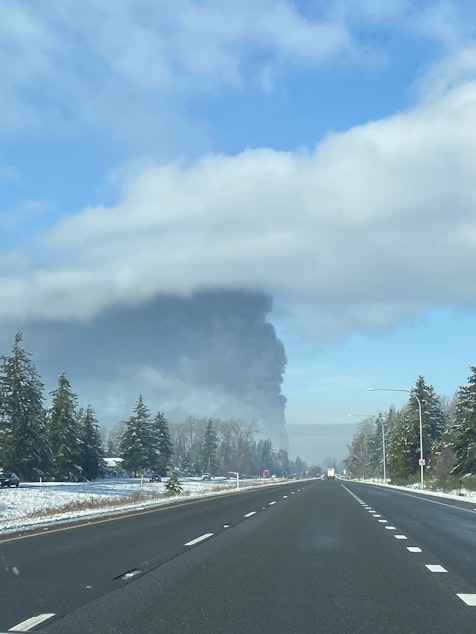
Phillips 66 officials say the refinery maintained normal operations throughout the rail closure.
BNSF resumed running oil trains to the BP and Phillips refineries on an adjacent track by Christmas Eve.
Repairs are still under way on the stretch of track torn apart by hundred-ton rail cars going astray.
Since the fire, oil trains have had to detour about four miles past the turnoff to the refineries, then reverse direction to make the turn.
Other than that delay of about two hours per train, the disaster had little impact on the flow of oil into and out of the state’s busy refineries.
READ Part 2 on the disaster’s possible causes, from track conditions to sabotage, that the FBI and others are investigating.
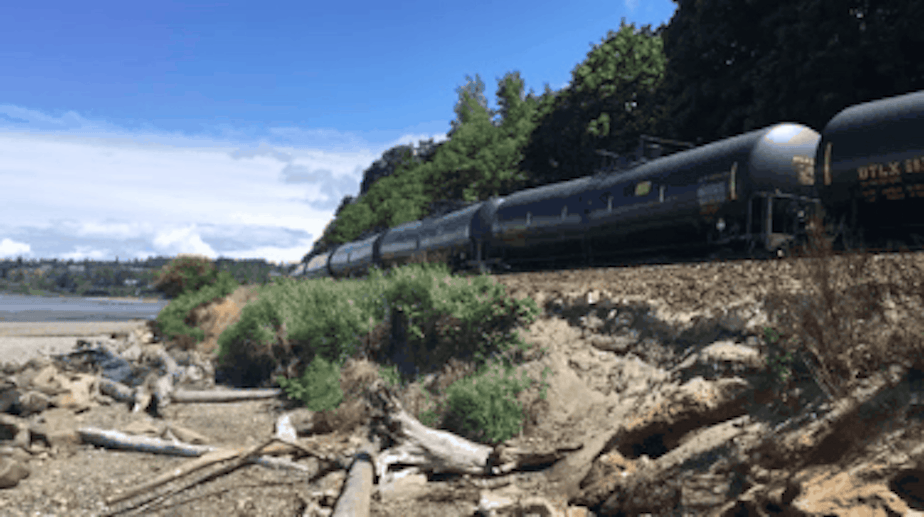
KUOW environment reporter John Ryan loves getting tips and documents. He can be reached at jryan@kuow.org, the encrypted heyjohnryan@protonmail.com or the encrypted Signal app at 1-401-405-1206 (whistleblowers, never do so from a work or government device, account or location). Snail mail is also a secure way to reach him confidentially: KUOW, 4518 University Way NE #310, Seattle, WA 98105. Don't put your return address on the outside.




